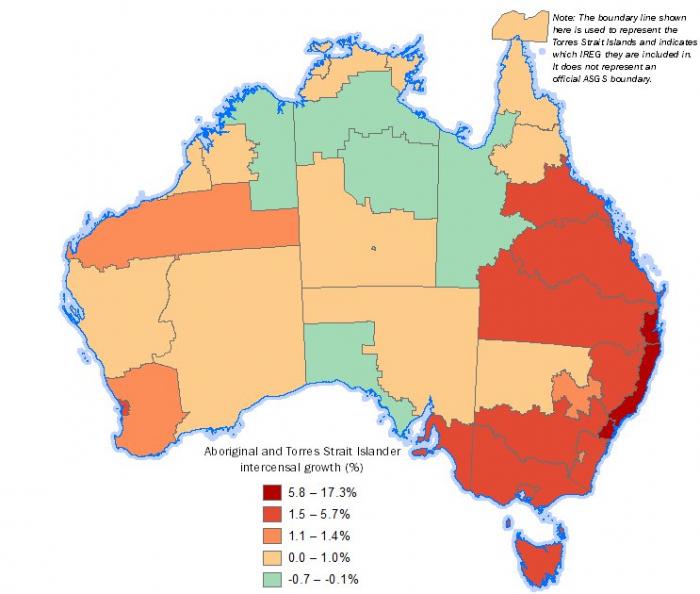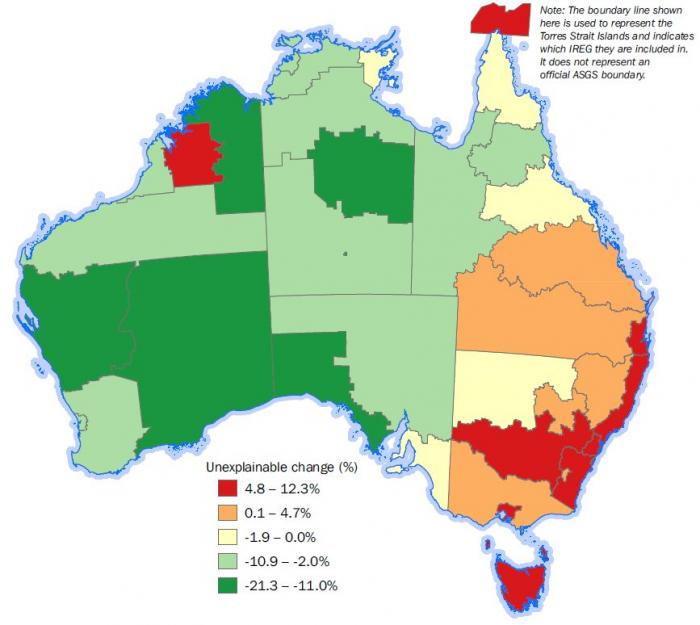Between the 2011 and 2016 Censuses, the number of Aboriginal and Torres Strait Islander people in Australia increased by 18.4% (100,803 people).
Large increases in the counts of Aboriginal and/or Torres Strait Islander people have been observed over various periods since 1971. Particularly-large increases occurred between the 1991 and 1996 Censuses (33.0%) and the 2006 and 2011 Censuses (20.5%). Factors contributing to these intercensal increases were explored in Occasional Paper: Population Issues, Indigenous Australians, 1996 (cat. no. 4708.0) and in the previous release of this publication after the 2011 Census.
Growth in counts of Aboriginal and Torres Strait Islanders, 1971-2016(a)
The purpose of this publication is to discuss factors contributing to the increase in counts of Aboriginal and Torres Strait Islander people observed between the 2011 and 2016 Censuses and their implications for interpreting and understanding Census data. This analysis is important because increases such as these have an impact on other statistics, such as population measures and/or performance indicators used for government reporting.
This analysis explores the components of the increase by breaking it down into its demographically-explainable and unexplainable components. Components including births and deaths, migration, a person’s propensity to identify as an Aboriginal and/or Torres Strait Islander person, and Census enumeration and response are all taken into account to help define and understand the intercensal increase.
Components of the Increase in Census Counts 2006 to 2016
Image

Description
The chapter Overview of the Increase examines how the Aboriginal and Torres Strait Islander population changed during the intercensal period. It shows that births between the 2011 and 2016 Censuses (0-4 year olds) are driving the majority of the intercensal increase (72.7%). The intercensal growth in counts of Aboriginal and Torres Strait Islander persons between 2011 and 2016 is not consistent across the country, with growth primarily occurring in Major cities and on the eastern coast of Australia. Population growth is significantly higher in Non-Remote areas (22.8%) than in Remote areas (2.0%).
The chapter Change Explained by Demographic Factors quantifies how much of the 100,803 increase in the Census count of Aboriginal and Torres Strait Islander people between 2011 and 2016 can be explained by demographic factors. It finds that most (78.6%) of the increase can be accounted for by explainable demographic factors of population change – births, deaths and migration.
The remaining 21.4% of the increase cannot be explained by typical factors of population change and equates to 3.3% of the total 2016 Census count of Aboriginal and Torres Strait Islander people (Change Not Explained by Demographic Factors). This increase did not occur consistently across the country and was primarily focused in Major Cities and Inner Regional areas, particularly in New South Wales.
Factors of unexplainable change in Census counts include: coverage, response rates and a changing propensity to identify. Analysis in this chapter shows that while the overall increase in Census counts is predominately composed of intercensal births (72.7%), other young children (5-14 year olds) were also a significant contributor (14.7%).
The chapter Changing Propensity to Identify examines peoples’ changing propensity to identify as Aboriginal and/or Torres Strait Islander. It finds that there is a relationship between changes in parental identification and changes in the identification of children. Children of couples where both parents are of Aboriginal and Torres Strait Islander origin – or children in lone parent families with an identifying parent – are more likely to be identified than children of couples where one person is of Aboriginal and Torres Strait Islander origin and the other is non-Indigenous.
The final chapter of this publication Impact of Intercensal Change on Selected Characteristics explores differences in the measures of socio-economic characteristics of Aboriginal and/or Torres Strait Islander people counted in the 2011 and 2016 Censuses, particularly for characteristics used to monitor progress against Closing the Gap targets (Education, Labour Force and Income). The chapter finds that attempting to measure the impact of changing propensity to identify is complex. Across all characteristics analysed, intercensal improvements appear to be a result of a combination of the changing population distribution of Aboriginal and Torres Strait Islander people across Remoteness areas, persons who are socio-economically better off choosing to identify, and actual progress.
There are three technical notes attached to this publication to provide background and context to the analysis. Technical Note 1 Aboriginal and Torres Strait Islander Status and the Census looks at the characteristics of people whose Indigenous Status is unknown. Technical Note 2 The undercount in the Census and the PES outlines Aboriginal and Torres Strait Islander undercount and overcount from the 2016 Post Enumeration Survey. The Aboriginal and Torres Strait Islander undercount increased slightly to 17.5% in 2016 (from 17.2%). Finally, the Technical Note 3 provides information on the Australian Census Longitudinal Dataset. For more information, please see the technical note sections on the Methodology page.



